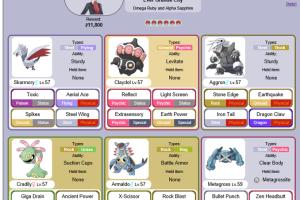Mastering Pokémon: How to Create a Balanced Team for Competitive Play

-
Quick Links:
- Introduction
- Understanding Pokémon Types
- Roles in a Pokémon Team
- Building Your Team
- Types and Weaknesses
- Strategies for Balance
- Case Studies
- Expert Insights
- Conclusion
- FAQs
Introduction
In the world of Pokémon, the key to victory is not just having the strongest Pokémon, but rather creating a balanced team that can adapt to various challenges. This article will guide you through the essentials of building a competitive Pokémon team that excels in various environments.
Understanding Pokémon Types
Every Pokémon belongs to one or two types, such as Fire, Water, Grass, Electric, etc. Understanding these types is crucial for creating a balanced team.
Type Matchups
Each type has strengths and weaknesses against others. For example:
- Water is strong against Fire but weak against Electric.
- Grass is strong against Water but weak against Fire.
This knowledge helps in selecting Pokémon that can counter the weaknesses of other team members.
Roles in a Pokémon Team
A balanced Pokémon team typically consists of several roles, each with a specific function:
- Tank: High defense and HP, absorbs damage.
- Attacker: High attack stats, deals damage quickly.
- Support: Provides buffs and heals team members.
- Special Attacker: Uses special moves to deal damage effectively.
Building Your Team
When constructing your team, consider the following steps:
- Choose a Core: Start with a few Pokémon that complement each other.
- Fill in Roles: Ensure you have a mix of tanks, attackers, and support Pokémon.
- Diversity: Incorporate different types to cover more matchups.
Types and Weaknesses
Once you've selected your core Pokémon, analyze their weaknesses. Create a balance by choosing Pokémon that can cover those weaknesses.
Example of Type Coverage
If your primary Pokémon is a Water type (weak to Electric), consider adding a Ground type to absorb Electric attacks.
Strategies for Balance
To maintain a balanced team, apply these strategies:
- Adaptability: Modify your team based on your opponents.
- Practice: Regularly battle with your team to identify weaknesses.
- Synergy: Ensure your Pokémon work well together. For example, using moves that enhance each other’s abilities.
Case Studies
Let’s examine successful teams and the strategies they employed:
Case Study 1: The Winning Team
A competitive team that excelled in tournaments comprised a Fire type for offense, a Water type for defense, and a Psychic type for support. This combination allowed flexibility and adaptability in battles.
Case Study 2: The Balanced Approach
Another team utilized a mix of Fighting, Fairy, and Steel types, which covered various weaknesses and provided a strong defense against common threats.
Expert Insights
Leading Pokémon trainers share their thoughts on balance:
"Always think about synergy. Some Pokémon may not shine individually, but together they can dominate the battlefield." - Ash Ketchum
Conclusion
Creating a balanced Pokémon team requires understanding types, roles, and strategies. By carefully selecting Pokémon that complement each other, you can build a team that withstands various challenges and excels in competitive play.
FAQs
1. How many Pokémon should be on my team?
Typically, a balanced team consists of six Pokémon to cover various roles and types.
2. What is the best type combination?
There is no definitive answer, but combinations like Dragon/Flying or Water/Ground are often considered very strong.
3. How do I know if my team is balanced?
Test your team against various opponents to identify weaknesses and adjust your lineup accordingly.
4. Can I have duplicate types on my team?
Yes, having duplicate types can be beneficial if they fulfill different roles effectively.
5. What is the importance of synergy in a team?
Synergy allows your Pokémon to support each other with moves that enhance their abilities, making your team more formidable.
6. How often should I change my team?
Change your team based on your experiences and the evolving competitive landscape.
7. Are Pokémon abilities important?
Yes, abilities can significantly impact your team’s performance and should be considered when building your lineup.
8. What role does EV training play in team balance?
Effort Value (EV) training helps optimize your Pokémon’s stats, making them more effective in their roles.
9. Can I use legendary Pokémon in my team?
Legendary Pokémon can be powerful, but they can also disrupt team synergy if not used wisely.
10. How do I counter common team strategies?
Study common strategies and build your team to counteract them with type advantages and diverse roles.
Random Reads